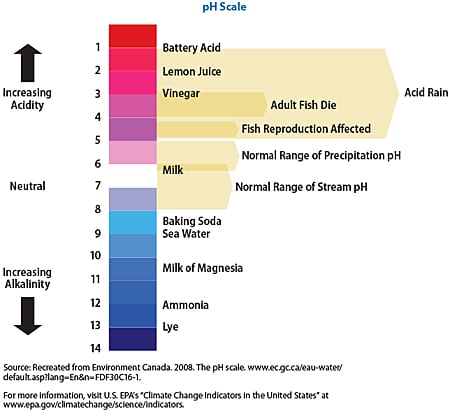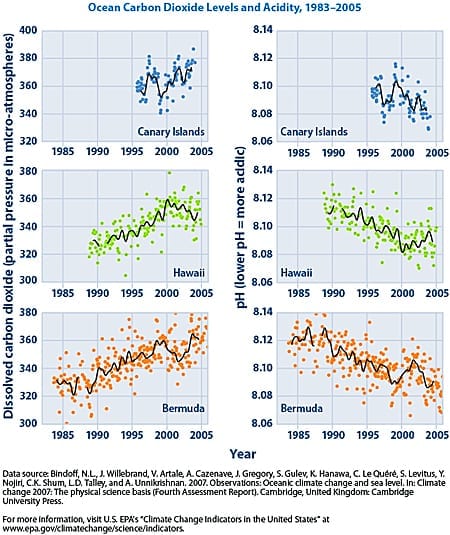By Daniel de la Calle
Considering this is the A Sea Change website on Ocean Acidification and not forgetting this denomination and the various effects of OA on diatoms, oysters, clownfish and whales I guess we should have included this graph a long time ago.
What is acid?:

≈≈≈≈≈≈≈≈≈≈≈≈≈≈≈≈≈≈≈≈≈≈≈≈≈
This one is very interesting as well:
The graphs on PDF HERE
In the study of acidification research is carried out all around the planet, inland and offshore, thanks to large buoys crammed with equipment and inside mini-labs, in the tropical Great Barrier Reef and along the frozen arctic:
The international Heron Island project uses a small lab-in-a-box to create future ocean conditions in two to six feet deep shallow waters. Inside this controlled environment scientists test the reaction of a few local corals to different future (pH) scenarios. The study has been published in SCIENTIFIC REPORTS. It was made possible thanks to a complex device named Coral Proto – Free Ocean Carbon Enrichment (CP-FOCE) that “uses a network of sensors to monitor water conditions and maintain experimental pH levels as offsets from environmental pH.” Check it out:

“A) Shows a wide view of the experimental system including the 3 CP-FOCE flumes and the wind generator. B) Photograph of the experimental float that has the 4, 12 V deep cycle batteries as ballast, and contains all of the control computers, peristaltic pumps, the solar panel, and the radio antennae to transmit the data real-time back to the laboratory. C) Schematic of a CP-FOCE flume showing the 3 experimental sections and the flow conditioners with CO2 enriched seawater injection sites. D) Photograph of a section of a CP-FOCE flume containing a rack with Acropora millepora corals and the pump that is turned on when the doors are closed to provide water movement. E) Schematic of the feed-back control between the pH sensors, flow sensor and the National Instrument control computers which decide which peristaltic pump to turn on and at what rate for the dosing.”
SOURCE
Further small-sized research has also been taking place some 10,000 miles away in the 100 degrees colder territories of the arctic. Dr. Oliver Wurl has been doing experiments on phytoplankton (the “forests of the oceans”, as he calls them) for the Catlin Arctic Survey. In this video that almost lets you feel the chilling wind Dr. Wurl talks about his project and the difficulty of working under extreme conditions.
Dozens of similar studies try to show when put together a broad picture of the way marine species will respond to future conditions. The final video below is a six minute mini-documentary on sea urchin larvae. Click on it to see how experts from Stanford University and Bodega Bay Marine Lab decipher the ways in which acidification will affect the 28,000 genes of the young spiny echinoderms.
“Ocean
Babies on Acid’ focuses on an experiment that Steve Palumbi of Stanford
and UC Davis marine biologist Eric Sanford have devised to study the
effects of ocean acidification on sea urchin larvae off the California
and Oregon coasts. One of their goals is to find out if the increased
acidity caused in part by increased CO2 levels in the atmosphere makes
it difficult for marine species to grow their shells. The study is
unique in that they’re not only studying the external aspects of these
creatures but also delving into how ocean acidification may effect the
animals on a genetic level.”



